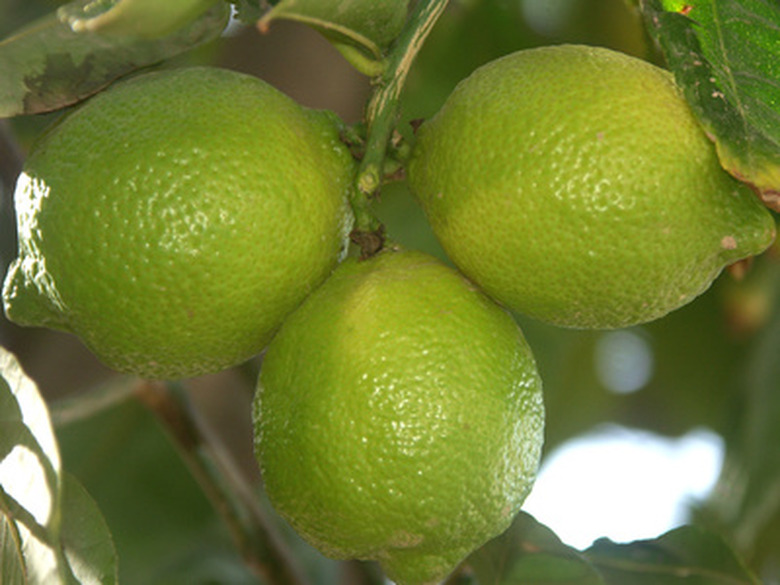Key Lime Tree Fertilizer
There are Persian, Indonesian, Palestinian sweet and Spanish limes, but the key lime is famous for the tangy flavor it gives the pies named after it. Key limes originated in Southeast Asia and were brought to the West Indies by Columbus. Tree-ripened key limes are bright yellow oval fruits with brown splotches that resemble lemons. Also known as Mexican or West Indian limes, the trees are extremely frost sensitive and heavy feeders.
Fruit
Aromatic, juicy and prized for their unique and complex acidic flavor, key limes (Citrus aurantiifolia) are small, walnut-sized, seedy ovals with thin skins. The juice is yellow-green and highly fragrant. Limes are sweeter than lemons but contain less vitamin C. Once grown commercially in the Florida Keys, they were nearly wiped out by a 1926 hurricane. Growers replanted thornless, sweeter-flavored, thicker-skinned, larger-fruited Persian limes, but key limes survive in the south, principally in Florida, where they are used to make Key Lime Pie.
- There are Persian, Indonesian, Palestinian sweet and Spanish limes, but the key lime is famous for the tangy flavor it gives the pies named after it.
- Limes are sweeter than lemons but contain less vitamin C. Once grown commercially in the Florida Keys, they were nearly wiped out by a 1926 hurricane.
Tree
Key lime trees are bushy evergreens that grow up to 8 feet tall. Their slender, crooked branches are full of thorns to protect the fruit. Extremely cold sensitive, they survive outdoors only in frost-free regions or with cold protection or indoors. They require soils with excellent surface and internal drainage. Horticulturalist Julian W. Sauls advises they will suffer from nutrient deficiency in soils high in caliche. Planted in the full sun on the south of the house in frost-free areas, they should provide bushels of limes.
Growing Conditions
Key limes are susceptible to root rot. Creating a shallow basin around the trunk to hold water will result in rot and kill the tree within five years, according to Dr. Sauls. Trees set higher than the nursery mark resist rot. New trees benefit from a 2-foot watering ring of soil piled several inches around the trunk and filled with water every other day for two weeks, then once a week.
- Key lime trees are bushy evergreens that grow up to 8 feet tall.
- Their slender, crooked branches are full of thorns to protect the fruit.
Fertilizer
Citrus fertilizer with a high nitrogen percentage (2-1-1 or 3-1-1) that includes trace amounts of manganese, iron and zinc is ideal for key limes. Slow-release fertilizer granules provide constant nutrients. Fertilize after trees show new growth with 1 cup of fertilizer split into three or four applications during the tree's first year. Sprinkle fertilizer around the trunk and water in thoroughly. Use two cups divided into three or four feedings the second year and continue adding a cup for every year of growth. Yellow leaves on a lime are a sign of inadequate fertilizer or bad drainage.
Container Growing
Good nutrition is vital to container plants. Feed key limes with water-soluble fertilizer when new growth begins. Use a balanced mix of nitrogen, phosphorus and potassium that includes small amounts of magnesium, iron, manganese, zinc and copper. Follow the guides on the label. If mature leaves are deep green, the tree is well nourished.
- Citrus fertilizer with a high nitrogen percentage (2-1-1 or 3-1-1) that includes trace amounts of manganese, iron and zinc is ideal for key limes.
- Yellow leaves on a lime are a sign of inadequate fertilizer or bad drainage.
